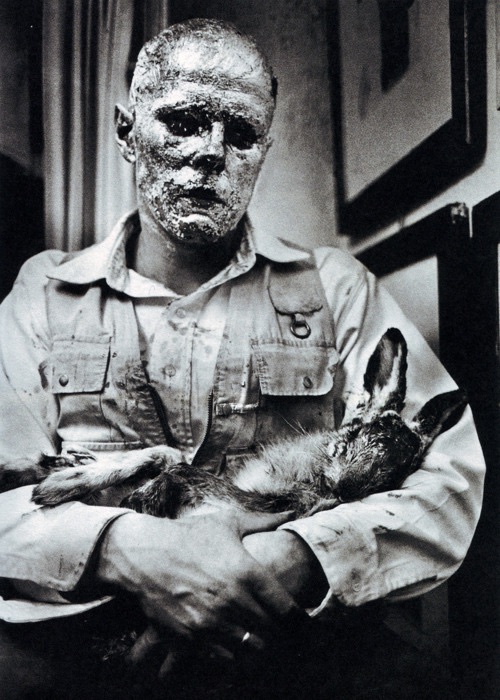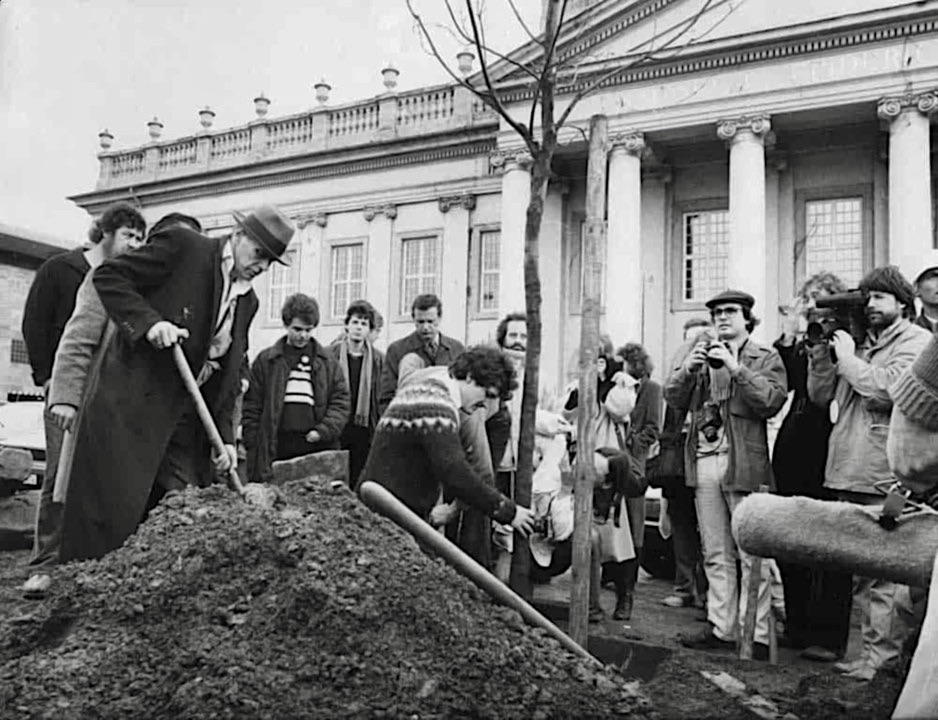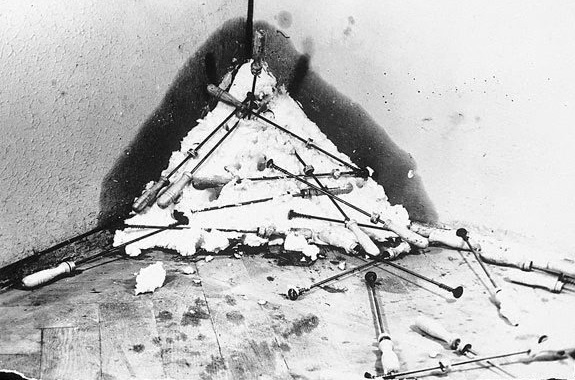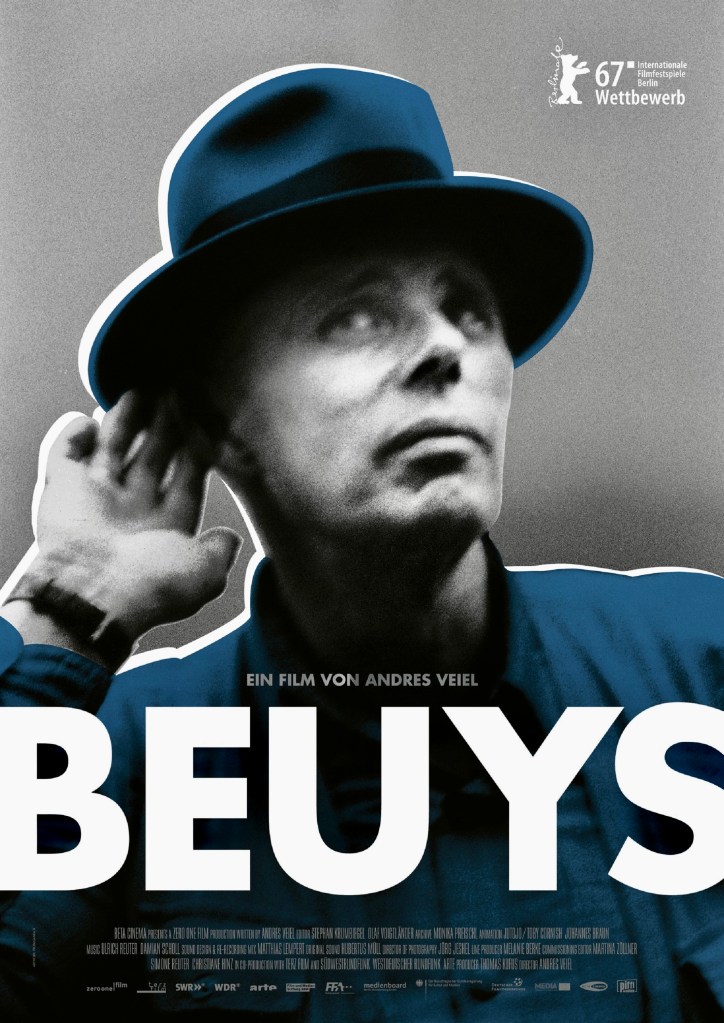As 2017 drew to a close, Hollywood studios and independent film distributors raced to release their best movies in order to qualify for Oscar consideration. The documentary category in particular was unusually strong that year with such critically acclaimed contenders as JR & Agnes Varda’s Faces Places, Ai Weiwei’s Human Flow and Errol Morris’s The B-Side: Elsa Dorfman’s Portrait Photography. Mostly overlooked among the many offerings, however, was a remarkably diverse portrait of the artist Joseph Beuys (1921-1986) from Germany entitled Beuys (2017), directed by Andres Veiel.

Beuys offers a complete immersion into pure, unadulterated Beuys, culled from rare live footage of his performance pieces, participatory happenings, debates with art critics and his charismatic interaction with students and fans. There is little about Beuys’s childhood or art training, however. His wife and two children are glimpsed but never properly introduced into the narrative, and most of his drawing, painting and sculpture of the late ’50s is glossed over in favor of what made him such a controversial figure in the German art world – and internationally – in the early ’60s. Although early critics of the documentary have complained that Veiel’s refusal to contextualize what he chose to focus on makes the film baffling to newcomers and frustrating for those familiar with Beuys, the documentary will be revelatory for anyone who wants to understand why Beuys is still considered important and influential today.
Veiel’s strategically curated footage supports most of Beuys’s more thought-provoking ideas and philosophies, such as the dictum that art should challenge the status quo to provoke social, political or environmental change, or that ritualized movement and sound presented as shamanistic or ephemeral performances can have a liberating effect on the artist and his audience. Beuys also preferred working with found or mass-produced objects and organic matter, which would later have an influence on Land art pioneers like Robert Smithson.

A psychological link between the artist’s frequent use of animal fat and felt and a traumatic, near-death experience during WWII is established toward the beginning of the film. Beuys always enjoyed blurring the line between fact and fiction and his version of the latter event has his plane being shot down over the Crimean Front in March 144 (he was a flier in the German Air Force) and him being rescued by a tribe of nomadic Tartars who treated his severe wounds by wrapping him in animal fat and felt. It is fascinating to see how these materials become recurring biographical themes in his work, from his dapper signature felt hat to key works like How to Explain Pictures to a Dead Hare (1965), Fat Corner (1968), and I Like America and America Likes Me (1974), a performance about the United States treatment of Native Americans for which he was wrapped in felt and transported on a stretcher to a room at New York’s René Block Gallery that he shared with a wild coyote for several days.

Veiel truly captures the essence and vitality of this artist who wore many hats: a mischievous prankster, an educator, a social activist (he helped found Germany’s Green Party) and a visionary who challenged staid ideas about art. One critic who classified Veiel’s portrait as hagiographic and took major issue of it was Oleg Ivanov of Slant Magazine who wrote, “The film’s most egregious omission is its failure to seriously address Beuys voluntarily joining the Hitler Youth and serving with the Luftwaffe. The issue of Beuys being an average Nazi before and during WWII is completely ignored. There’s no examination of his active participation in the Nazi war machine or his failure to acknowledge Germany’s role in the Holocaust throughout his career. Instead, the film glorifies the wounds he received after a crash during an air raid, without mentioning the victims of that or any other of the many raids he carried out during the war.”
On the positive side is Simon Abrams of The Village Voice who found Veiel’s documentary refreshingly atypical of the genre, writing, “Writer-director Andres Veiel’s decision to primarily represent present-day interviewees as disembodied voices gives viewers freedom to interpret Beuys’s lifelong dream of repositioning art as an egalitarian force for greater sociopolitical consciousness. The film becomes something of a choose-your-own-art-history-adventure… when you look at Beuys’s uneasy stare and broad grin, you see a restless visionary plotting his next big move. Veiel’s refreshingly open-ended approach invites you to find your own answers.”

Equally impressed was Daniel Larkin of Hyperallergic who stated, “Veiel made a choice to do what typical documentaries can’t. His scope was to introduce you to the raw presence of the artist, the timber of his voice, the way his face twists, and the complexities of his mannerisms. Whereas most documentaries leave you with an art historical abstraction projected onto a person, this film succeeds at familiarizing you with the living, breathing, mystical force of nature of Joseph Beuys.” As for myself, I came away from Beuys wanting to know more about his life and work, and what could be a better recommendation than that?

‘Fat corner’ by Joseph Beuys 1968, printed 1997
© Joseph Beuys/VG Bild-Kunst. Licensed by Copyright Agency
© Estate of Ute Klophaus
Photo: AGNSW
When Beuys was released in Germany in 2017 it was lauded at several film festivals including the Berlin International Film Festival where director Andres Veiel was nominated for the Golden Berlin Bear (Best Film) and Best Original Documentary, the German Film Awards (it won awards for Best Documentary and Best Editing by Bester Schnitt) and the Munich International Documentary Festival (it won the music award for composers Ulrich Reuter and Damian Scholl).

Beuys was released on DVD by Kino Lorber in May 2018 and includes an interview with the director and an excerpt from the 1988 documentary Joseph Beuys: Transformer by John Halpern.
*This is a revised and expanded version of an article that originally appeared on Burnaway.org.
Other links of interest:
https://www.artnews.com/feature/joseph-beuys-who-is-he-why-is-he-important-1234580650
https://www.theartstory.org/artist/beuys-joseph




